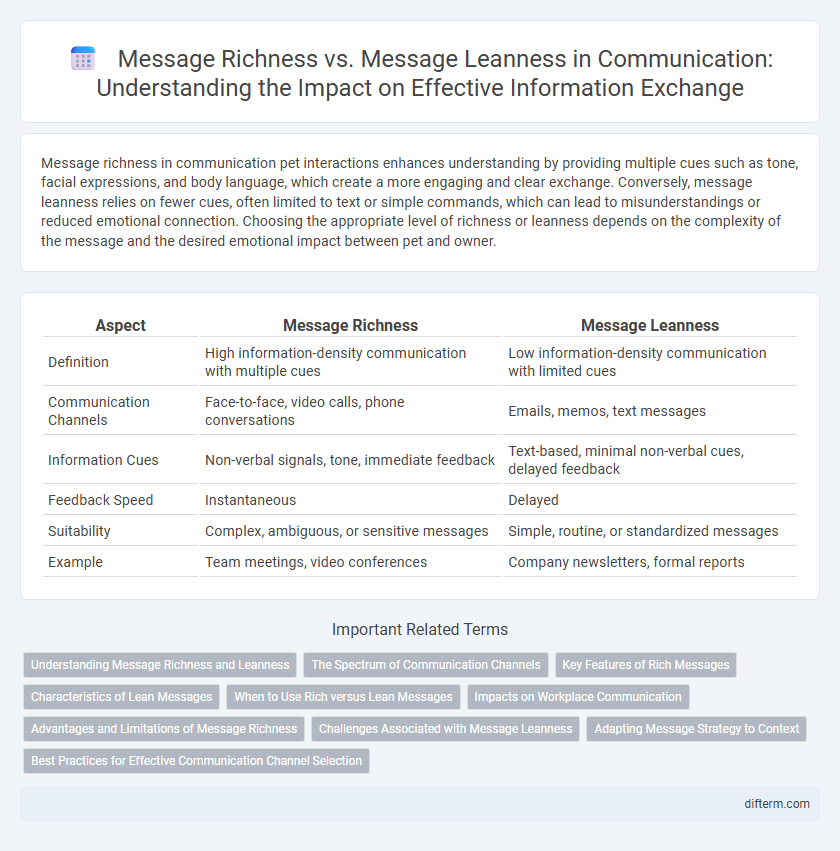Message richness in communication pet interactions enhances understanding by providing multiple cues such as tone, facial expressions, and body language, which create a more engaging and clear exchange. Conversely, message leanness relies on fewer cues, often limited to text or simple commands, which can lead to misunderstandings or reduced emotional connection. Choosing the appropriate level of richness or leanness depends on the complexity of the message and the desired emotional impact between pet and owner.
Table of Comparison
| Aspect | Message Richness | Message Leanness |
|---|---|---|
| Definition | High information-density communication with multiple cues | Low information-density communication with limited cues |
| Communication Channels | Face-to-face, video calls, phone conversations | Emails, memos, text messages |
| Information Cues | Non-verbal signals, tone, immediate feedback | Text-based, minimal non-verbal cues, delayed feedback |
| Feedback Speed | Instantaneous | Delayed |
| Suitability | Complex, ambiguous, or sensitive messages | Simple, routine, or standardized messages |
| Example | Team meetings, video conferences | Company newsletters, formal reports |
Understanding Message Richness and Leanness
Message richness refers to the capacity of a communication medium to convey nuanced information through multiple cues such as tone, body language, and immediate feedback, enhancing understanding and reducing ambiguity. In contrast, message leanness involves limited cues and slower feedback, often resulting in less effective transmission of complex or emotional content. Selecting appropriate media based on richness or leanness is crucial for optimizing communication effectiveness in various contexts.
The Spectrum of Communication Channels
Message richness ranges from lean channels like emails and memos, which provide minimal immediate feedback, to rich channels such as face-to-face and video conferencing that convey verbal and nonverbal cues, fostering deeper understanding. The spectrum of communication channels impacts message clarity, as richer media reduce ambiguity through immediate interaction and emotional context. Selecting the right channel depends on message complexity, urgency, and the need for feedback to enhance effective communication.
Key Features of Rich Messages
Rich messages are characterized by their ability to convey multiple cues simultaneously, including visual, auditory, and nonverbal signals, enhancing understanding and reducing ambiguity. They facilitate immediate feedback, enabling real-time clarification and more dynamic interaction. High message richness improves message comprehension in complex or emotionally charged conversations by providing context and nuanced meaning.
Characteristics of Lean Messages
Lean messages are characterized by limited nonverbal cues, relying primarily on text or numbers, which restricts emotional expression and immediate feedback. They are efficient for straightforward, routine information but may lead to misunderstandings in complex or ambiguous situations due to their low information richness. Examples include emails, memos, and formal reports, where clarity and brevity take precedence over depth and nuance.
When to Use Rich versus Lean Messages
Choose rich messages for complex, ambiguous topics requiring immediate feedback, such as face-to-face meetings or video calls, to clarify misunderstandings quickly. Lean messages, including emails or memos, suit straightforward, routine information where documentation and low social presence are essential. Matching message richness to the communication context enhances understanding and efficiency in professional and personal interactions.
Impacts on Workplace Communication
Message richness enhances workplace communication by providing multiple cues such as tone, body language, and immediate feedback, which reduces misunderstandings and fosters stronger collaboration. Lean messages, often text-based or asynchronous, can lead to ambiguity and misinterpretation, slowing decision-making and increasing errors in complex tasks. Selecting the appropriate channel based on message complexity improves clarity, efficiency, and overall team performance in professional environments.
Advantages and Limitations of Message Richness
Message richness offers advantages such as enhanced clarity and reduced ambiguity by allowing the use of multiple cues like tone, body language, and immediate feedback in communication. However, its limitations include potential information overload and increased time or resource consumption, making it less efficient for simple or routine messages. Rich communication is most effective in complex or sensitive contexts requiring nuanced understanding, while overuse may hinder concise message delivery.
Challenges Associated with Message Leanness
Message leanness in communication often leads to challenges such as misinterpretation, lack of emotional cues, and ambiguity, reducing the effectiveness of information exchange. Text-based communication channels like emails and instant messaging typically exhibit message leanness, making it difficult to convey tone and intent accurately. These limitations can increase misunderstandings and decrease relational satisfaction, especially in complex or sensitive interactions.
Adapting Message Strategy to Context
Message richness varies depending on the complexity and ambiguity of the communication context, with richer media like face-to-face or video conferencing preferred for nuanced, emotionally charged, or complex messages. Leaner media such as emails or memos are more effective for straightforward, routine, or less ambiguous information. Adapting the message strategy to the communication context ensures clarity, reduces misunderstandings, and enhances overall effectiveness.
Best Practices for Effective Communication Channel Selection
Selecting an effective communication channel requires balancing message richness and leanness to match content complexity and audience needs. Rich channels like face-to-face or video calls convey nonverbal cues and allow immediate feedback, enhancing understanding in complex or sensitive discussions. Lean channels such as email or text messaging suit straightforward, routine information sharing where brevity and documentation are prioritized.
message richness vs message leanness Infographic

 difterm.com
difterm.com